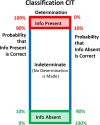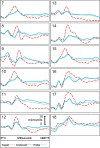Brain fingerprinting field study on major, terrorist crimes supports the brain fingerprinting scientific standards hypothesis: classification concealed information test with P300 and P300-MERMER succeeds; comparison CIT fails
- PMID: 36704633
- PMCID: PMC9871152
- DOI: 10.1007/s11571-022-09795-1
Brain fingerprinting field study on major, terrorist crimes supports the brain fingerprinting scientific standards hypothesis: classification concealed information test with P300 and P300-MERMER succeeds; comparison CIT fails
Abstract
We conducted (I) 18 event-related potential (ERP) field tests to detect concealed information regarding major terrorist crimes and other real-world crimes and (II) 5 ERP tests regarding participation in a classified counterterrorism operation. This study is a test of the brain fingerprinting scientific standards hypothesis: that a specific set of methods for event-related potential (ERP) concealed information tests (CIT) known as the brain fingerprinting scientific standards provide the sufficient conditions to produce less than 1% error rate and greater than 95% median statistical confidence for individual determinations of whether the tested information is stored in each subject's brain. All previous published results in all laboratories are compatible with this hypothesis. We recorded P300 and P300-MERMER ERP responses to visual text stimuli of three types: targets contain known information, irrelevants contain unknown/irrelevant information, and probes contain the situation-relevant information to be tested, known only to the perpetrator and investigators. Classification CIT produced significantly better results than comparison CIT, independent of classification criteria. Classification CIT had 0% error rate; comparison CIT had 6% error rate. As in previous studies, classification-CIT median statistical confidences were approximately 99%, whereas comparison CIT statistical confidences were no better than chance for information-absent (IA) subjects (who did not know the tested information). Over half of the comparison-CIT IA determinations were invalid due to a less-than-chance computed probability of being correct. Experiment (I) results for median statistical confidence: Classification CIT, IA subjects: 98.6%; information-present (IP) subjects (who know the tested information): 99.9%; comparison CIT, IA subjects: 48.7%; IP subjects: 99.5%. Experiment (II) results (Classification CIT): error rate 0%, median statistical confidence 96.6%. Countermeasures had no effect on the classification CIT. These results, like all previous results in our laboratory and all others, support the brain fingerprinting scientific standards hypothesis and indicate that the classification CIT is a necessary condition for a reliable, accurate, and valid brainwave-based CIT. The comparison CIT, by contrast, produces high error rates and IA statistical confidences no better than chance.
Supplementary information: The online version contains supplementary material available at 10.1007/s11571-022-09795-1.
Keywords: Brain fingerprinting; Classification CIT; Comparison CIT; Concealed information test; Counterterrorism; Criminal investigation; Detection of concealed information; ERP; Field study; Forensic neuroscience; Forensic science; Guilty knowledge test; Lie detection; MERMER; P300; P300-MERMER; Scientific standards; Terrorism.
© The Author(s), under exclusive licence to Springer Nature B.V. 2022.
Conflict of interest statement
Conflicts of interestAuthor Farwell has received compensation for related work from Harvard University, the US Central Intelligence Agency, the US Federal Bureau of Investigation, multiple intelligence, counterterrorism, and law enforcement agencies in other countries, the University of Illinois, Brain Fingerprinting Laboratories, Inc., Brain Fingerprinting, LLC, and the Wisconsin Innocence Project. He is a principal in Brain Fingerprinting Laboratories, Inc. and Brain Fingerprinting, LLC. He is the inventor of three related US patents and one related UK patent. He is the author of two books containing related information.
Figures











Similar articles
-
Brain fingerprinting classification concealed information test detects US Navy military medical information with P300.Front Neurosci. 2014 Dec 23;8:410. doi: 10.3389/fnins.2014.00410. eCollection 2014. Front Neurosci. 2014. PMID: 25565941 Free PMC article.
-
Brain fingerprinting field studies comparing P300-MERMER and P300 brainwave responses in the detection of concealed information.Cogn Neurodyn. 2013 Aug;7(4):263-99. doi: 10.1007/s11571-012-9230-0. Epub 2012 Dec 5. Cogn Neurodyn. 2013. PMID: 23869200 Free PMC article.
-
Brain fingerprinting: a comprehensive tutorial review of detection of concealed information with event-related brain potentials.Cogn Neurodyn. 2012 Apr;6(2):115-54. doi: 10.1007/s11571-012-9192-2. Epub 2012 Feb 17. Cogn Neurodyn. 2012. PMID: 23542949 Free PMC article.
-
Neurophysiological Approaches to Lie Detection: A Systematic Review.Brain Sci. 2025 May 18;15(5):519. doi: 10.3390/brainsci15050519. Brain Sci. 2025. PMID: 40426690 Free PMC article. Review.
-
P300 in detecting concealed information and deception: A review.Psychophysiology. 2020 Jul;57(7):e13362. doi: 10.1111/psyp.13362. Epub 2019 Mar 11. Psychophysiology. 2020. PMID: 30859600 Review.
References
-
- Efron B. Bootstrap methods: another look at the jackknife. Ann Stat. 1979;7:1–26. doi: 10.1214/aos/1176344552. - DOI
-
- Farwell LA. Brain fingerprinting: corrections to Rosenfeld. Sci Rev Mental Health Pract. 2011;8(2):56–68.
LinkOut - more resources
Full Text Sources
Research Materials
Miscellaneous

